Introduction
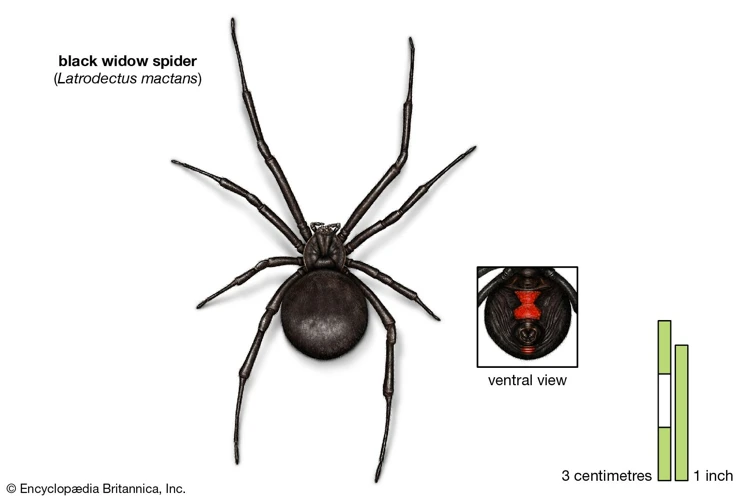
When it comes to spiders, the Black Widow Spider is one of the most recognizable and notorious species. With their shiny black bodies and the signature red hourglass shape on the female’s abdomen, these spiders can go from being a fascinating sight to a potential danger depending on the circumstances. One question that has often been asked is whether these spiders are more common in urban or rural habitats. In this article, we will explore the factors that influence where Black Widow Spiders can be commonly found and what you can do to protect yourself from them.
What are Black Widow Spiders?
| Black Widow Spider | Description |
| Family | Theridiidae |
| Scientific Name | Latrodectus |
| Appearance | The female black widow spider is typically larger than the male, and has a shiny black body with a red hourglass-shaped marking on its belly. The male is smaller and usually has lighter-colored spots on its back. |
| Habitat | Black widow spiders are found throughout the world, but are most common in temperate regions like the United States. They are typically found in dark, secluded areas like woodpiles, abandoned buildings, and cluttered spaces. |
| Bite | The venom of the black widow spider is poisonous and can be dangerous to humans. Symptoms of a black widow spider bite can include pain, muscle spasms, and chills. In severe cases, the bite can be fatal. |
Black widow spiders are a species of venomous spider that are found around the world, but are most prevalent in temperate regions like the United States. These spiders are known for their shiny black bodies and distinctive red hourglass-shaped markings on their abdomens. While the females are larger and more recognizable, the males also have unique markings on their backs. The black widow spider can be found in a wide variety of habitats, from abandoned buildings to cluttered spaces. However, these spiders typically prefer dark, secluded areas like woodpiles and basements. It’s important to be cautious around black widow spiders, as their venom can be dangerous and even fatal to humans. For tips on identifying black widow spider habitats and preventing infestations, check out our article on Checking Black Widow Spider Habitats.
Black Widow Spider Habitat
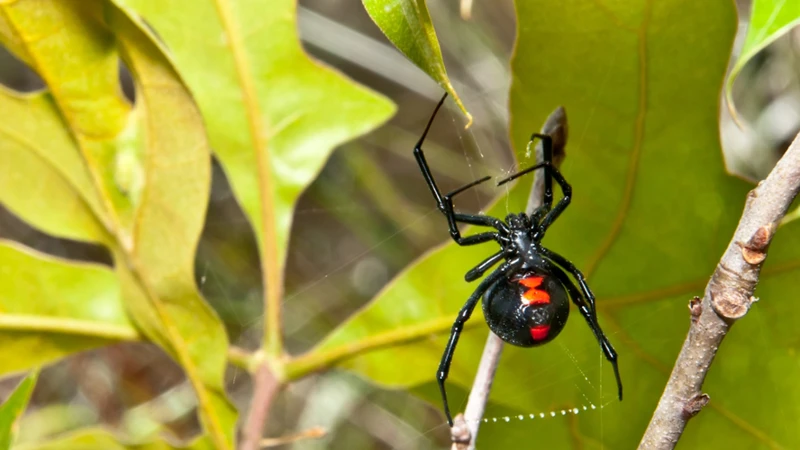
The habitat of black widow spiders can be found in various locations, from rural to urban environments. These venomous spiders have adapted to different habitats and can thrive in both indoor and outdoor environments. However, the question remains – are black widow spiders more common in urban or rural habitats? Several factors influence the presence of black widow spiders, and we will explore them in this section. We will also cover how to identify black widow spider presence and how to prevent and control infestations. Before delving deeper, let’s understand what black widow spiders are and their characteristics.
Rural Habitat
Black widow spiders can be found in various habitats, including rural areas. Rural habitats are often characterized by large open spaces with low population densities and little human disturbance. These environments can be conducive to the growth and proliferation of black widow spider populations.
Table: Comparison of Black Widow Spider Presence in Rural and Urban Habitats
| Factors | Rural Habitats | Urban Habitats |
|---|---|---|
| Population Density | Low | High |
| Human Disturbance | Little | High |
| Vegetation | Lush | Less vegetation |
| Food Sources | Abundant | Scarcity |
| Prevalence | More common | Less common |
Rural habitats provide ideal conditions for black widow spiders as they have access to plentiful food sources and ample vegetation for hiding and spinning their webs. These spiders can be found in various outdoor locations, including gardens, fields, and woodlands.
While black widow spiders are more common in rural areas, they can still be found in urban areas as well. For example, abandoned buildings or structures can be prime breeding grounds for black widow spiders in urban areas. Additionally, these spiders can easily make their way into homes in search of shelter and food, especially during colder months.
It is important to note that black widow spiders can be dangerous, and their presence should be taken seriously regardless of the habitat. If you suspect a black widow spider infestation in your home or on your property, it is best to seek professional pest control services to ensure their safe removal.
Urban Habitat
Urban Habitat:
Black widow spiders can also be found in urban areas. In fact, due to human activity, it is often easier for them to survive in urban habitats. Many structures in urban areas provide the perfect hiding spots for black widows. They typically prefer dark, undisturbed areas, such as garages, sheds, and basements. They thrive in areas with a warmer climate and plenty of food sources, which are often present in populated areas.
The table below shows some common urban habitats where black widows could be found, along with a brief description of why these areas appeal to them:
| Urban Habitat | Description |
|---|---|
| Garages and Sheds | Dark and quiet, often filled with clutter, providing ample hiding spots for black widows |
| Basements and Crawlspaces | Dark and damp, providing a suitable environment for spiders to thrive |
| Outdoor Seating Areas | Cushions and decorations provide places for black widows to hide and wait for prey |
| Trash and Recycling Bins | Often contain debris and food waste, attracting insects which black widows feed on |
| Playground Equipment | Undisturbed areas under playground equipment provide an ideal location for spiders to spin their webs and prey on insects |
With the increase in urbanization, black widows are becoming more common in cities and towns. It is important for homeowners to be aware of their presence and take necessary precautions to prevent infestations in their homes.
Factors that Influence Black Widow Presence
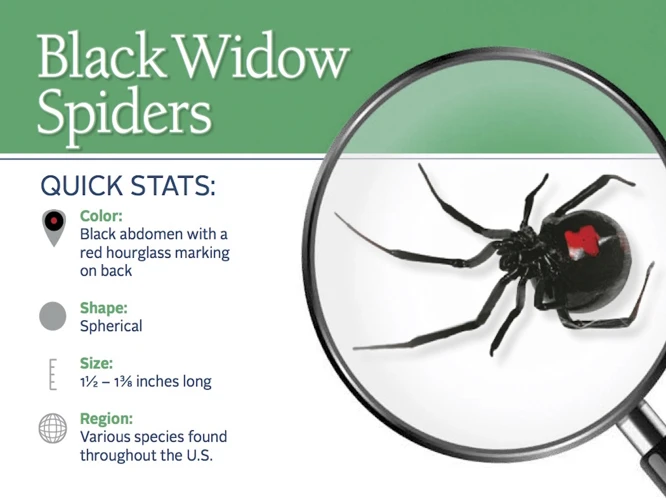
Various factors can significantly influence the presence of black widow spiders in different habitats. Understanding these factors can help individuals determine the likelihood of a black widow spider infestation and take action to prevent it. From the influence of climate and human activity to the availability of suitable habitats, these elements play a crucial role in determining where black widow spiders thrive. Knowing these factors can help individuals understand how to protect themselves from black widow spider bites and create a safer environment for their families.
Climate
When it comes to the presence of black widow spiders, climate is one of the factors that play a role. Black widow spiders are predominantly found in warm climates, with temperatures ranging from 70 to 90°F being ideal. They are most commonly found in the southern region of the United States, with a smaller number found in the western and eastern regions. Humidity is also a contributing factor, with higher humidity levels being more conducive to black widow spider populations.
Table: Black Widow Spider Populations Across the United States
| Region | Black Widow Spider Population |
|---|---|
| Southern Region | Most prevalent |
| Western Region | Moderately prevalent |
| Eastern Region | Least prevalent |
While temperature and humidity play a role in the presence of black widow spiders, it’s important to note that they can still be found in other climate conditions. However, their populations tend to be much smaller in cooler or dryer regions.
It’s also worth noting that climate change may have an impact on the habitats of black widow spiders. As temperatures rise and weather patterns shift, their populations may expand or contract depending on the availability of suitable habitats.
While climate is a factor in the presence of black widow spiders, it’s important to consider other factors as well, such as human activity and habitat destruction. To learn more about the impact of these factors on black widow spider habitats, check out our article on habitat destruction.
Human Activity
Human activity is another factor that influences the frequency of black widow spiders in an area. These spiders tend to thrive in areas where humans have a significant impact on the environment. This is because human activity often creates the perfect habitat for these arachnids. For example, abandoned or neglected buildings that are cluttered with debris and junk provide the prime habitat for black widow spiders. They build their webs in these areas, and can easily catch prey that is wandering around.
Another reason that human activity can attract black widow spiders is that it can create the perfect climate for these spiders to thrive. They prefer warm, shady areas, so if you have a lot of clutter around your home, this can provide a perfect hiding spot for them to lay their eggs. Additionally, areas around homes that are damp and humid, or have standing water, can attract these spiders as they seek out moisture.
Indoor and outdoor habitats can also be affected by human activity. Black widow spiders tend to be more common in outdoor locations that are rarely disturbed by humans, such as wood piles, sheds, garages, and crawl spaces. Inside a house, they can be found in corners, closets, attics, and basements.
To prevent a black widow spider infestation, it is important to keep the surrounding areas clean and clutter-free. It is also essential to seal all holes and entry points that spiders could use to gain entrance to your home. Professional pest control services can also be utilized if a black widow spider infestation is detected. By being aware of the potential habitats for black widow spiders and actively taking steps to control their presence, it is possible to minimize the likelihood of their establishing themselves in your home and reduce the likelihood of being bitten by these venomous spiders.
Source: Human Impact on Black Widow Spider Habitats
Dangers of Black Widow Spider Bites
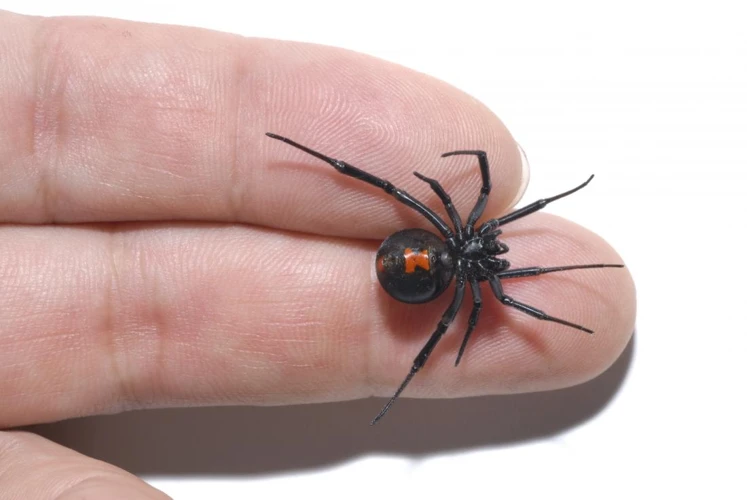
Dangers of Black Widow Spider Bites
Black widow spiders are known to be venomous, and their bites can cause several health complications. It is important to understand the various symptoms of black widow spider bites to ensure prompt medical attention.
The venom of female black widow spiders is considered to be more potent than that of male black widow spiders, as females are more inclined towards defensive behavior. Symptoms of a black widow spider bite may include swelling, redness, intense pain, cramps, chills, sweating, and abdominal pain. In some severe cases, the symptoms may lead to muscle stiffness, tremors, and convulsions.
The severity of the symptoms may vary depending on the amount of venom injected, the bitten individual’s sensitivity to the venom and their overall health. Children, elderly individuals, and people with weakened immune systems are at higher risk of serious complications.
It is advisable to seek prompt medical attention if you believe you’ve been bitten by a black widow spider. Treatment may include anti-venom medication, muscle relaxants, and painkillers. Early and effective treatment can prevent the venom from spreading and may prevent further complications.
It is important to note that not all bites from black widow spiders result in severe symptoms, and many people may not even realize that they’ve been bitten. However, it is always better to be safe than sorry when dealing with venomous spiders.
It is vital to take steps to prevent black widow spider infestations in your home or workplace to avoid the risk of bites. If you suspect the presence of black widow spiders, it is best to call a professional pest control service to handle the problem efficiently and safely.
Identifying black widow spider habitats in your home and taking necessary precautions can go a long way in protecting yourself and your loved ones from the dangers of black widow spider bites.
How to Identify Black Widow Spider Presence
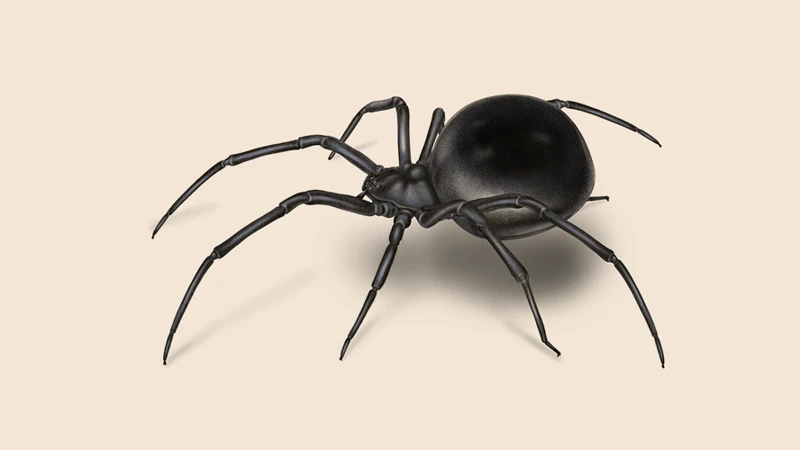
How to Identify Black Widow Spider Presence
Identifying black widow spiders can be a bit tricky as they are known to be very good at hiding. Typically, they hide in dark and quiet areas, so homeowners should be on the lookout for webs in those areas. A common spider web is a sign that a spider is present, but there are some characteristics that set black widow spider webs apart from other spiders.
Black widow spider webs are typically irregular in shape and are located near the ground. They are usually found in corners, under furniture, or in storage areas. The webs are very strong, almost like a fabric, and may have a messy appearance compared to other spider webs.
Another way to identify black widow spider presence is by looking at the spider itself. These spiders are usually black with a red or orange hourglass-shaped mark on their underside. However, not all black widow spiders have this distinctive mark. In fact, some may have red spots or no markings at all.
It is important to note that black widow spiders are venomous and their bites can be dangerous. It is best to avoid contact with them if possible. If you do find one in or around your home, it is best to take the proper safety precautions before attempting to remove it or call a professional pest control company.
Click here to learn about abandoned habitats where black widow spiders might hide.
Preventions and Control Measures for Black Widow Spider Infestations
As the venom of black widow spiders can be quite dangerous and potentially lethal, it is important to take measures to prevent and control infestations. Effective prevention and control can reduce the chances of encountering these venomous arachnids. By implementing the following measures, you can help keep black widow spiders at bay and minimize the risks associated with their presence.
Keep Homes Clean and Clutter-Free
Keeping your home clean and free of clutter is one effective way of preventing black widow spider infestations. Black widows are attracted to areas where they have access to prey, and clutter provides an ideal hiding place for their prey. A clean and clutter-free home is unappealing to black widows. Here are some tips to help you keep your home clean and clutter-free:
- Vacuum Regularly: Regular vacuuming can help to eliminate potential hiding places for black widows and their prey. Focus on hidden corners, crevices, and dark areas that are often overlooked, such as behind furniture and curtains.
- Reduce Clutter: Clutter provides excellent hiding places for spiders and their prey. Remove piles of magazines, newspapers, and cardboard boxes from your home and only keep essential items.
- Store Clothes Properly: Store clothing and other textiles properly to prevent black widow spiders from nesting in them. Seal off unused clothing and blankets in airtight bags or containers. Before wearing any stored clothing, check them carefully for spiders.
- Keep Outdoor Areas Clean and Tidy: Black widows can easily move from outdoor areas to inside your home. Keep your outdoor areas free of clutter and debris, trim back plants along the perimeter of your home, store firewood away from the house, and check shoes and other outdoor gear thoroughly before bringing them inside.
- Maintain Home Repairs: Cracks and crevices in your home can be entry points for black widow spiders. Check your home’s interior and exterior for cracks and crevices and seal them properly. Repair damaged screens, windows, and doors, and make sure that they close tightly.
By following these tips, you can help to create a home that is unappealing to black widow spiders. However, if you suspect that you have a black widow infestation, it’s essential to seek the help of a professional pest control company to eliminate the problem safely.
Sealing of Home Entries
When it comes to preventing black widow spider infestations, sealing all possible entries into the home can be extremely effective. Sealing these entry points not only prevents black widow spiders from entering the home, but can also help prevent other pests from entering as well. These are some of the ways that you can seal the entry points into your home:
- Seal windows and doors: Ensure that all your windows and doors have proper weather stripping and sealant. This will prevent black widow spiders and other pests from entering your home through gaps around your windows and doors.
- Seal cracks and crevices: Black widow spiders can easily enter your home through small gaps found in the foundation, walls, or roof. Seal these gaps using a silicone-based caulk or other suitable sealants to prevent spiders from finding their way into your home.
- Install a door sweep: If you do not have a door sweep, then you should install one as soon as possible. A door sweep can effectively seal gaps found underneath doors, which is a common entry point for many pests including black widow spiders.
- Inspect outdoor items: Ensure that all outdoor items like firewood, garbage cans, and other storage containers do not create any openings that can allow black widow spiders to enter your home.
Sealing your home’s entry points is an effective way to protect against black widow spiders and other pests. However, it should be noted that this method is only effective if there are no existing black widow spiders inside your home. If there are already black widow spiders present in the home, then a combination of sealing entry points and professional pest control measures may be necessary.
Professional Pest Control
Professional pest control is an effective solution for managing black widow spider infestations, especially when infestations become severe. Pest control professionals are trained to find and eliminate black widow spider populations, including identifying nesting sites and removing eggs. Additionally, they can use specialized treatments to control spider populations, such as insecticides and baits.
When seeking professional pest control services, it is important to select a reputable and experienced company, as not all pest control providers are created equal. Look for providers with a track record of success in managing black widow spider infestations, as well as certifications and licenses from recognized organizations.
Here are some advantages of seeking professional pest control:
- Expertise: Pest control professionals are knowledgeable in the behavior and habits of black widow spiders. They can quickly identify the source of the infestation and use the appropriate methods to remove it.
- Safety: Professional pest control services are safe for humans and pets and help to prevent future infestations.
- Long-term solutions: Pest control providers use specialized equipment and products to ensure that the infestation is eliminated and will not return in the future.
- Save time and money: While DIY solutions may seem like a cost-effective option, they are often less effective than professional services and may require multiple treatments, which can be more expensive in the long run.
When working with a pest control professional, it is important to follow their recommendations and take steps to prevent future infestations. This may include sealing entry points into your home, reducing clutter, and removing sources of food and water for spiders.
If you are dealing with a black widow spider infestation, seeking professional pest control services may be the best solution. By working with a trusted provider, you can eliminate the infestation and ensure that your home remains free of black widow spiders in the future.
Click here to learn more about how climate can influence black widow spider habitats.
Conclusion
As we’ve learned, black widow spiders can be found in both rural and urban habitats, but their presence can be influenced by factors such as climate and human activity. It is important to take precautions and prevent black widow spider infestations in residential and commercial areas, as their venomous bites can pose serious health risks.
While it may be difficult to completely eradicate these spiders from our environments, there are measures that can be taken to reduce their numbers. Keeping homes clean and clutter-free, sealing off entryways, and enlisting the help of professional pest control services are all effective ways to control black widow spider populations.
If you suspect that there may be black widow spiders present in your area, it is important to learn how to identify them and take necessary precautions. We recommend checking out our article on how to check for black widow spiders when house hunting to learn more about identifying these spiders in your home or business.
In addition, understanding the habitats and behaviors of black widow spiders can help you better prepare and prevent infestations. We suggest reading our article on indoor and outdoor black widow spider habitats to gain a better understanding of where these spiders are commonly found.
Remember, prevention and knowledge are key when it comes to dealing with black widow spiders. By taking necessary precautions and staying informed on their behaviors and habitats, we can better protect ourselves and our environments from these potentially dangerous arachnids.
Frequently Asked Questions
What Attracts Black Widow Spiders?
Black Widow Spiders are attracted to dark, secluded areas that provide shelter and food sources. These include cluttered areas, woodpiles, and areas with high insect activity.
Are Black Widow Spiders More Common in Urban or Rural Areas?
There isn’t a clear answer to this, as black widow spiders can be found in both urban and rural areas. However, they tend to thrive in areas with warm climates, such as the southern United States.
What Time of Year Are Black Widows Most Active?
Black Widow Spiders are most active during the warmer months, typically late spring through early fall.
What Color Are Black Widow Spiders?
Black Widow Spiders are typically black or dark brown, with a distinctive red or orange hourglass shape on their abdomen.
What Are the Signs of Black Widow Spider Infestation?
Signs of a black widow spider infestation may include the presence of spider webs in dark, secluded areas, the sighting of black widow spiders, or the presence of their egg sacs.
Do All Black Widow Spiders Have Venomous Bites?
Yes, all black widow spiders are venomous. However, not all bites result in severe symptoms, and it is possible to be bitten without even realizing it.
What Are the Symptoms of a Black Widow Spider Bite?
Symptoms of a black widow spider bite may include sharp pains at the bite site, muscle cramps, nausea, and difficulty breathing. In severe cases, these symptoms can lead to hospitalization.
How Can I Keep My Home Safe From Black Widow Spiders?
You can keep your home safe from black widow spiders by keeping it clean and clutter-free, sealing any entry points, and investing in professional pest control services.
Can Black Widow Spiders Climb Walls?
Yes, black widow spiders are known for their ability to climb walls and other surfaces.
What Should I Do If I am Bitten by a Black Widow Spider?
If you are bitten by a black widow spider, seek medical attention immediately. Apply an ice pack to the bite site and keep the affected area elevated until medical help arrives.






